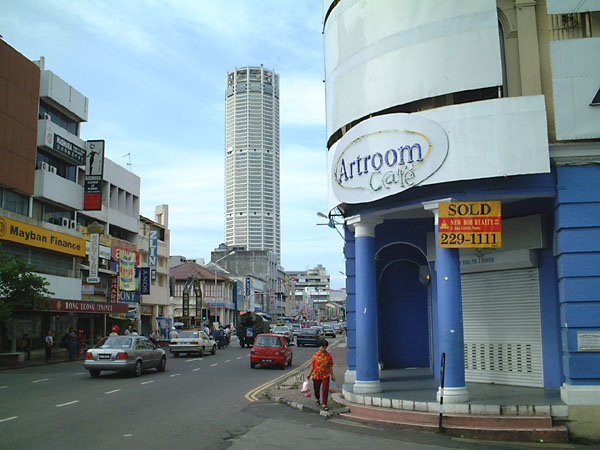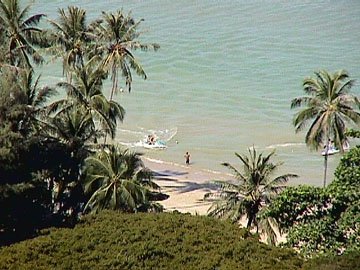|
Introduction
Introduction of Penang
 Penang Island or Pulau Pinang, founded by British East India Company Captain
Francis Light in the 18th century, was an important trading station in Malay
Peninsula during the 19th century. However, it declined in importance when
Singapore, off the southern tip of the peninsula, rose to prominence in the
1820s.
Penang Island or Pulau Pinang, founded by British East India Company Captain
Francis Light in the 18th century, was an important trading station in Malay
Peninsula during the 19th century. However, it declined in importance when
Singapore, off the southern tip of the peninsula, rose to prominence in the
1820s.
Penang had a good natural harbor where ship captains could wait out the
fierce monsoon, do a little quiet trading in Kedah, Perlis, Perak or
Sumatera, and return to Calcutta in India after the winds had changed.
Penang still relies on commerce for a living, including the tourist trade.
Tin from southern Thailand and Perak is smelted in Penang.
Rubber-processing, textile manufacture and food production are sited here.
Thai rice is imported in bulk and redistributed throughout Malaysia from
Penang.
Ferries regularly ply between Georgetown on the island, and Butterworth on
the mainland. Regular air services also link Penang to Peninsula and the
world.
Perfect Island Getaway
 Penang,'The Pearl Of The Orient', has always held an attraction for
visitors, ever since Captain Francis Light persuaded the Sultan of Kedah to
cede the island to the British East India Company in 1786. Originally named
Prince Of Wales Island, it quickly became an important trading post due to
its strategic location, dominating the business in tea, spices, china,
textiles, and later, tin as well as rubber. Today, it is firmly entrenched
as a popular tourist destination for locals and foreigners. Many reasons are
put forward for this, among them being the unique ambience of an island
cum-city-state, the great food, the relaxed pace of life that prevails and
its rich fascinating history. Whatever it may be, thing is for sure -
visitors from all walks of life will always find something that satisfies
their fancy and induce them to return for more in the future.
Penang,'The Pearl Of The Orient', has always held an attraction for
visitors, ever since Captain Francis Light persuaded the Sultan of Kedah to
cede the island to the British East India Company in 1786. Originally named
Prince Of Wales Island, it quickly became an important trading post due to
its strategic location, dominating the business in tea, spices, china,
textiles, and later, tin as well as rubber. Today, it is firmly entrenched
as a popular tourist destination for locals and foreigners. Many reasons are
put forward for this, among them being the unique ambience of an island
cum-city-state, the great food, the relaxed pace of life that prevails and
its rich fascinating history. Whatever it may be, thing is for sure -
visitors from all walks of life will always find something that satisfies
their fancy and induce them to return for more in the future.
The People
With the various migrants who have come and gone through Penang over time,
it is not surprising that the island could be one of the most multi-cultural
melting pots in the world. The initial Malay settlers were joined by
Europeans, Chinese, Indians and many others and the resulted cross-cultural
interactions have resulted in the rich ethnic composition that exists today.
The respective cultures, food, language, festivals and architecture make
Penang one of the most interesting historical states in Malaysia.
Religion
Like the rest of Malaysia the official religion of Penang is Islam, however
Penang state is very tolerant of the many religions and faiths that are
practiced within its state, in other words there is 'freedom of worship'.
Aside from Islam, Buddhism, Taoism, Hindu and Christianity are prominent. Of
note - each faith has on the island a building of worship that is well worth
a visit.
The Language
Bahasa Melayu is the national language and the medium of instruction in
local educational establishments. English is taught as a second language but
is widely spoken and generally understood. In Penang, many Asian languages
and dialects are also spoken and understood. These include Mandarin and
other Chinese dialects such as Hokkien, Hakka (Khek), Cantonese, Tamil and
other Indian dialects, Thai and
The Climate
Sitting right on the equator Penang's climate is referred to as equatorial.
There are no real recognizable hot and cold seasons in Penang. Rain falls
fairly regularly all year round, although the heaviest showers are said to
occur between August and November. The temperature consistently falls
between a pleasant 23 degrees and 32 degrees Celsius, although humidity can
be high. Click here for 5-day forecast.
Brief History
Penang had been, prior to the English, known as a harbor for pirates. Then
in 1786 the Sultan of Kedah ceded the state of Penang (Pulau Pinang), also
known as Betelnut Island to Captain Francis Light of the East India Company
in return for British protection. It was England's first stronghold in Asia,
and they quickly populated the island and made it an important port within
the Straits of Malacca. In 30 years the population boomed from almost nil to
10,000 with Georgetown as the capital. During World War II, the 'Pearl of
the Orient' was invaded by the Japanese. At the same time the English
departed.
Food Haven
Penang is surely a paradise for people who live to eat. One can sample
different dishes for every meal and not have to taste the same food for
weeks! Penang Nyonya food, which differs from the Malacca version, is widely
acknowledged as one of Malaysia's finest cuisines and has made a name for
itself internationally. Some swear by hawker food like Hokkien Mee, Laksa,
Char Koay Teow, Nasi Kandar - the list is endless. Western cuisine is also
widely available at hotels and fine restaurants, catering to the many
Westerners who flock to this island.
Places of Interest and Accommodation
Tourists interested in history will find Georgetown, the administrative
centre of Penang, especially intriguing, as the rich heritage has left a
legacy of buildings and sites that have their unique stories to tell. Kek
Lok Si Temple Snake Temple and Khoo Kongsi are some attractions that should
not be missed. The tourist belt of Batu Ferringhi and Tanjung Bungah on the
northeastern coast of Penang is the playground for visitors who love the sun
and sea. A wide range of fine accommodation facilities is available to suit
all budgets, including Penang Mutiara Beach Resort, Shangri-La Rasa Sayang
and Crown Prince Hotel and in the city area, Sheraton Penang, The City
Bayview Hotel, Shangri-La and many others.
Penang Cultural Centre
The Penang Cultural Centre (PCC) is best summed up as an all-in-one cultural
theme park that offers a glimpse of the diverse cultures of Malaysia in a
nutshell. This award-winning attraction, dubbed as 'Instant Malaysia' by
Malaysia Airlines, is located in the Teluk Bahang area and has been busy
since it opened, offering visitors an entertaining-cum-educational
experience. Within the 14-acre compound are various attractions like the
Cultural Village and The Istana, a Malay Theatre Restaurant. One of the
highlights of any visit to PCC must be the spectacular cultural performance
by the PCC is Dancers, who have achieved international fame, and appeared
frequently in other countries. More information can be obtained at http://www.geovision.com.my/pcc
Penang's Heritage Trails
Penang, after the English seafarer, Captain Francis Light, first lay claim
on behalf of the British East India Company in 1786, soon became a vital
port-of-call to mariners and merchants from the far corners of the Old World
plying the seas to the richness of the East.
In those days, the island must have been a colorful, bustling intermingling
of traders of different races and creeds. Historically, they have left
behind a legacy in traditions and architecture that infuses many of the
streets in Georgetown with an ambience of far away and long ago days, when
life was harsher but simpler, and, possibly, more exciting.
Though Penang today is a modern metropolis, the island still reeks pungently
of yesteryears through the narrow streets and gloomy corridors of
Colonial-style structures and Chinese kongsi quarters.
To keep the heritage alive, the Penang State Tourism Department has created
a Heritage Trail for taking in some of the major structures and streets of
historical significance. This journey into Penang's "living heritage" can be
taken on foot but best in a traditional trishaw.
Miscellaneous Facts
Currency: Ringgit Malaysia (MYR). RM3.80 = USD1 approx.
Time Zone: +8.00 GMT.
|


 Penang,'The Pearl Of The Orient', has always held an attraction for
visitors, ever since Captain Francis Light persuaded the Sultan of Kedah to
cede the island to the British East India Company in 1786. Originally named
Prince Of Wales Island, it quickly became an important trading post due to
its strategic location, dominating the business in tea, spices, china,
textiles, and later, tin as well as rubber. Today, it is firmly entrenched
as a popular tourist destination for locals and foreigners. Many reasons are
put forward for this, among them being the unique ambience of an island
cum-city-state, the great food, the relaxed pace of life that prevails and
its rich fascinating history. Whatever it may be, thing is for sure -
visitors from all walks of life will always find something that satisfies
their fancy and induce them to return for more in the future.
Penang,'The Pearl Of The Orient', has always held an attraction for
visitors, ever since Captain Francis Light persuaded the Sultan of Kedah to
cede the island to the British East India Company in 1786. Originally named
Prince Of Wales Island, it quickly became an important trading post due to
its strategic location, dominating the business in tea, spices, china,
textiles, and later, tin as well as rubber. Today, it is firmly entrenched
as a popular tourist destination for locals and foreigners. Many reasons are
put forward for this, among them being the unique ambience of an island
cum-city-state, the great food, the relaxed pace of life that prevails and
its rich fascinating history. Whatever it may be, thing is for sure -
visitors from all walks of life will always find something that satisfies
their fancy and induce them to return for more in the future.